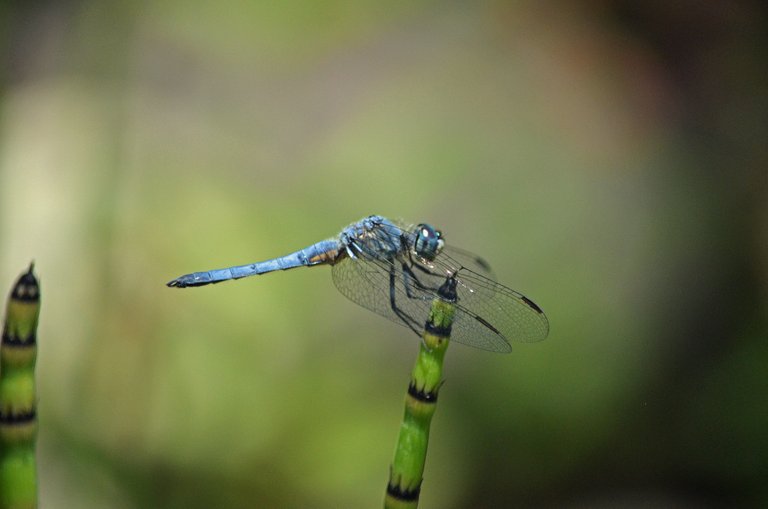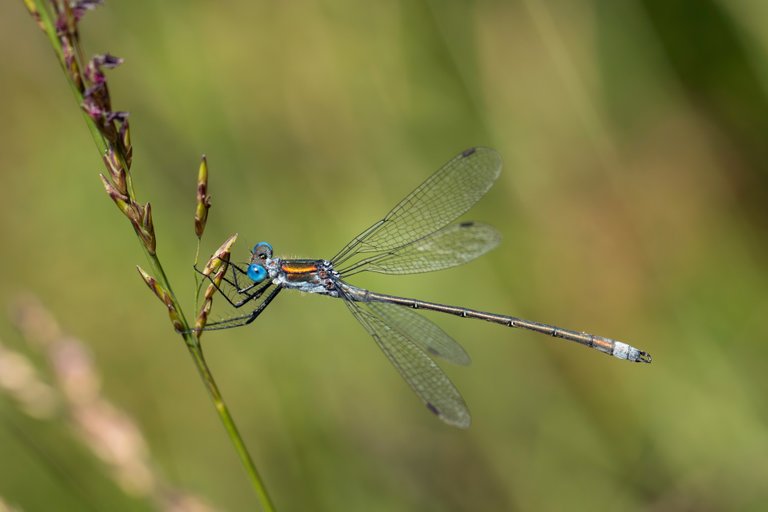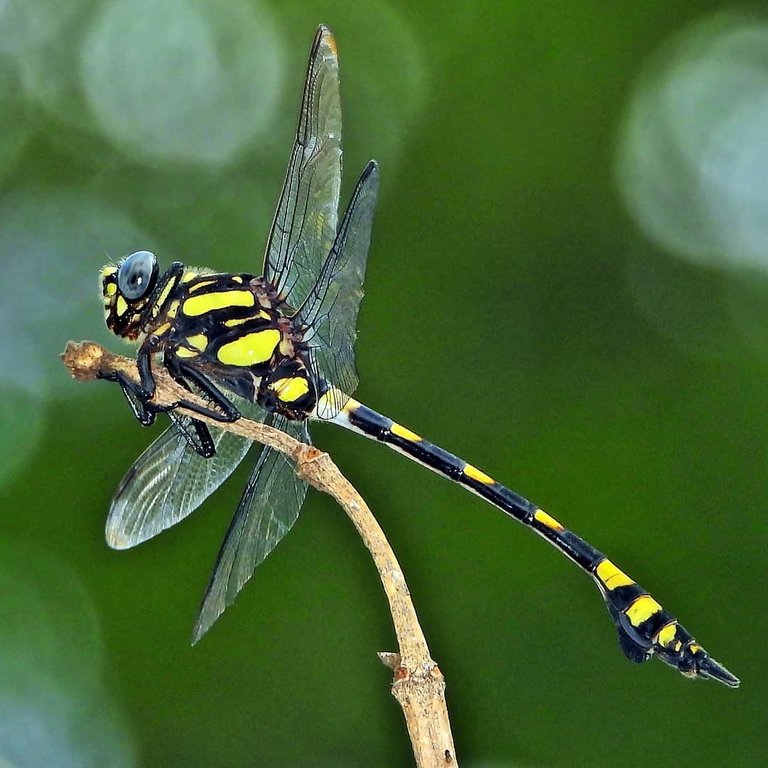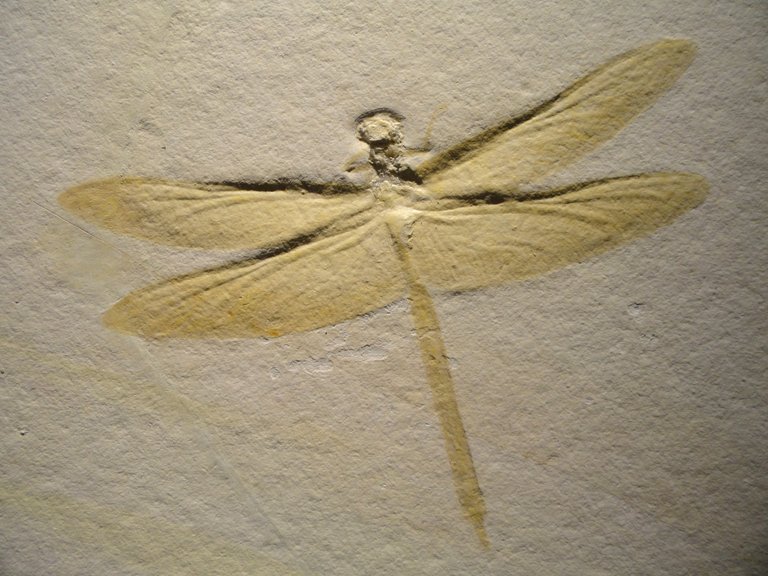The Dragonfly: Ferocious Predator, Gardener's Friend
Bees and monarch butterflies are welcome guests in most gardens. There's another winged visitor that deserves an equally warm embrace: the dragonfly.
Dragonfly in Flight, Laos

Image credit: Basile Morin CC 4.0

Dragonflies, and a near relative, damselfies, are ferocious hunters. This is bad news for garden pests. These hunters do the job of pest clearance that otherwise might be left to noxious chemicals. According to Texas A&M Agrilife, adult dragonflies eat anything they can fit in their mouths: "Mosquitoes, gnats, flies, flying ants, swarming termites, mayflies, midges, butterflies (even big swallowtails), damselflies, other dragonflies..." A YouTube video shows the dragonfly in action as it captures and consumes a mosquito. (Be on notice: this is not a pleasant sight.)
Dragonflies and damselflies are members of the Odonata order and are sometimes described as the most effective predators in the natural world. An article in Oxford Academics Integrative and Comparative Biology offers statistics on the dragonfly's capture and kill success rate. The rate varies by dragonfly species. The Blue Dasher dragonfly successfully attempts and captures fruit flies 97.1% of the time.
Male Blue Dasher

Image credit: Laredawg. CC-BY-SA-4.0 license
Capture success rates for mosquitoes and houseflies are less, although still impressive. The success averages about 75% and 66%, respectively. Larval dragonflies, called nymphs, are also effective hunters. They comb underwater terrains for anything consumable. Smithsonian Magazine reports that these consumables include: "tadpoles, mosquitoes, fish, other insect larvae and even each other".
Dragonfly Nymph

Picture credit: Maximilian Paradiz from Merida, Mexico. CC 2.0 license
A nymph may live, underwater, for as long as five years. An adult will live for perhaps a few weeks or at most as long as six months. Most likely though, according to Dragonfly-Site.com, dragonflies will be eaten before they die a natural death.

Dragonflies have been around for about 300 million years, which makes them one of the oldest insect species in the world. The earliest dragonflies would have been formidable opponents, for their wing span, judging by fossil remains, was about two feet.
Dragonfly From the Late, Late Jurassic
Image credit: Daderot. From the Houston Museum of Natural Science. Public domain.
This specimen was found in lithographic limestone, in Solnhofen, Bavaria, Germany.

Today, an estimated 5,000 species of dragonfly have been identified. Recently, a new species was discovered in the mountains of Laos and Cambodia.
Differences Between Dragonflies and Damselflies
According to the Forest Preserve District of Will County, Illinois,(USA), these are differences between damselflies and dragonflies. First of all, damselflies are smaller and do not fly as far or as fast as dragonflies. Then:
 Dragonflies have larger eyes that wrap around their heads.
Dragonflies have larger eyes that wrap around their heads.
 Damselflies have smaller, thinner bodies that resemble twigs.
Damselflies have smaller, thinner bodies that resemble twigs.
 Damselfly wings are more slender, and taper toward the base.
Damselfly wings are more slender, and taper toward the base.
 When at rest, a dragonfly's wings stick straight up. A damselfly's wings rest alongside the body, giving the insect a slender, streamlined appearance.
When at rest, a dragonfly's wings stick straight up. A damselfly's wings rest alongside the body, giving the insect a slender, streamlined appearance.
Damselfly

Image credit: Charles J. Sharp. CC license 4.0
This is an Emerald damselfly. Picture taken in Warren Heath, Hampshire, England. Hampshire is known for its abundance of dragonflies.
Dragonfly

Image credit: Aneesh15,Sangli,CC.4.0.*
This is a common clubtail dragonfly. Picture taken in Maharashtra State.

Amazing Visual Processing of the Dragonfly
The ability of the dragonfly to anticipate the flight path of its prey has been compared to a ballplayer's ability to anticipate the arc of a ball in a crowded stadium. This complex relationship between the brain and the eye has only been observed so far in mammals. Though a dragonfly brain is less complex than a human brain, engineers developing robotics may benefit from studying the way this insect tracks prey.
Dragonfly Eye

Author: David L. Green. Used under a CC 3.0 license
The citation under this picture notes: "The image perceived by the arthropod is "recalculated" from the numerous ommatidia which point in slightly different directions." and "Dragonflies have about 30,000 facets to their compound eyes, giving them nearly a 360° field of vision".

Dragonflies in the Ecology
Not only are dragonflies useful to the gardener because they help to control pests, but they are also important as a prey species. They are food for: "Birds...bats...frogs...spiders...lizards, robber flies, and even other dragonflies." Nymphs are fed upon so regularly by fish, that some dragonfly species will only breed in waters that have no fish.
There is one other important dragonfly predator: humans.
According to the Food and Agricultural Organization of the United Nations, dragonfly nymphs are a nutrition source in areas of food insecurity. Generally, the nymphs are harvested when people are collecting other foodstuffs, such as crabs. The eating of insects, in general, is called entomophagy.

Dragonflies as Bioindicatos
An article in the International Journal of Biodiversity and Conservation explains that the presence of dragonflies is an important indicator for ecological balance. The dragonfly will only lay its eggs in freshwater. A great number of dragonflies in an area is considered a sign that water is fresh. The authors of the article assert: "The greatest numbers of species are found at sites that offer a wide variety of microhabitats". And, it seems, dragonflies are more sensitive to pollutants than damselflies.

Conclusion
A few days ago, @zoragarcia posted some pictures of a dragonfly. That's how this blog began. These are insects that were familiar to me since childhood, but I knew nothing about them. Now I know a little more.
Thank you, @zoragarcia for the inspiration.



 : as a GIF and as an accent, adapted from Pixabay photo
: as a GIF and as an accent, adapted from Pixabay photo

A very enriching post in verbal and visual information, with those excellent photographs. Until now, I was not clear about the difference between dragonflies and damselflies. Thanks and greetings, @agmoore.
Thank you so much for visiting and for those kind words. Before I wrote this post, I didn't know what damselflies were. Isn't Hive a great adventure :)
I hope you are well and peaceful, @josemalavem.
Warm regards.
Thanks for sharing this informative post about dragonfly. I have just learned from your post that dragonfly has been around for 300 million years back then.
!tan - Please help me tip @agmoore
Congratulations, @andyjim You Successfully Trended The Post Shared By @agmoore.
You Utilized 2/3 Daily Summon Bot Calls.
TAN Current Market Price : 0.300 HIVE
Thank you for visiting my post and commenting. I was thinking about those early dragonflies last night. Imagine running across one of them. We'd probably be dinner :))
Yes, I'll give you a small tip. Happy Halloween!
@agmoore - Very much thanks. :-)